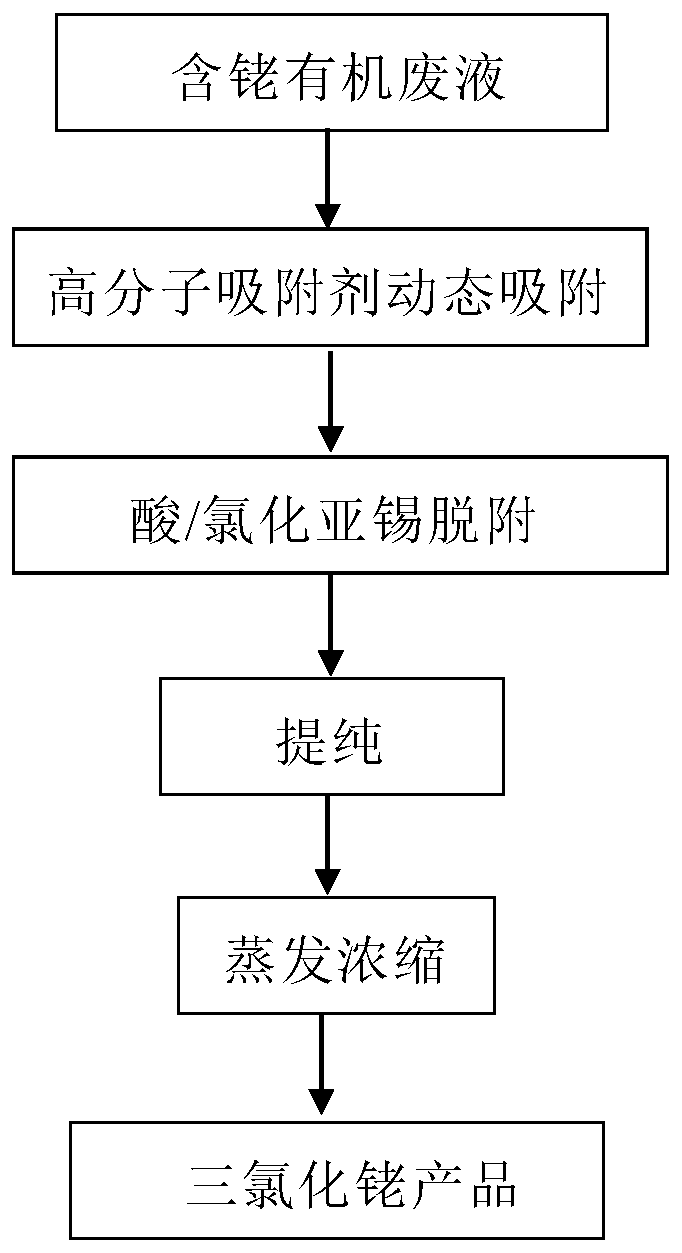Method for recovering rhodium from rhodium-containing organic wastewater to prepare rhodium chloride
An organic waste liquid, rhodium trichloride technology, applied in chemical instruments and methods, inorganic chemistry, preparation of ruthenium/rhodium/palladium/osmium/iridium/platinum compounds, etc., to achieve large adsorption capacity, easy operation, high adsorption rate high effect
- Summary
- Abstract
- Description
- Claims
- Application Information
AI Technical Summary
Problems solved by technology
Method used
Image
Examples
Embodiment 1
[0034] Step 1. Adsorption: Adsorb the rhodium in the rhodium-containing organic waste liquid produced in the production process of the rhodium homogeneous catalyst onto the polymer adsorbent in the form of dynamic adsorption to obtain the rhodium-containing adsorbent; the specific process is: A polymer adsorbent with imino groups (such as a polymer bonded with dihydrocarbyl sulfide, the polymer is a polymer of N,N-methylenebisacrylamide and vinylimidazole, or Polymer of ethylene glycol dimethacrylate and acrylic acid) 10g filled into In the adsorption column, use a peristaltic pump to pass 1500mL rhodium-containing organic waste liquid through the adsorption column at a speed of 1mL / min, and the rhodium in the rhodium-containing organic waste liquid is adsorbed on the polymer adsorbent in the form of dynamic adsorption to obtain agent; the temperature of the adsorption is 25 ℃, and the mass content of rhodium in the rhodium-containing organic waste liquid is 156ppm; the rhod...
Embodiment 2
[0042] Step 1. Adsorption: Adsorb the rhodium in the rhodium-containing organic waste liquid produced in the production process of the rhodium homogeneous catalyst onto the polymer adsorbent in the form of dynamic adsorption to obtain the rhodium-containing adsorbent; the specific process is: the rhodium containing sulfoxide Polymer adsorbents with groups and imino groups (such as polymers bonded with dihydrocarbyl sulfoxides, wherein the polymers are polymers of N,N-methylenebisacrylamide and vinylimidazole, or polymer of ethylene glycol dimethacrylate and acrylic acid) 10g filled into In the adsorption column, use a peristaltic pump to pass 30000mL rhodium-containing organic waste liquid through the adsorption column at a speed of 30mL / min, and the rhodium in the rhodium-containing organic waste liquid is adsorbed on the polymer adsorbent in the form of dynamic adsorption to obtain agent; the temperature of the adsorption is 40 ℃, and the mass content of rhodium in the rhod...
Embodiment 3
[0050] Step 1. Adsorption: Adsorb the rhodium in the rhodium-containing organic waste liquid generated during the production process of the rhodium homogeneous catalyst onto the polymer adsorbent in the form of dynamic adsorption to obtain the rhodium-containing adsorbent; the specific process is: containing sulfoxide group and a polymer adsorbent of imino group (such as a polymer bonded with dihydrocarbyl sulfoxide, wherein the polymer is a polymer of N,N-methylenebisacrylamide and vinylimidazole, or Polymer of ethylene glycol dimethacrylate and acrylic acid) 50g filled into In the adsorption column, use a peristaltic pump to pass 5000mL of rhodium-containing organic waste liquid through the adsorption column at a speed of 1mL / min, and the rhodium in the rhodium-containing organic waste liquid is adsorbed on the polymer adsorbent in the form of dynamic adsorption to obtain agent; the temperature of the adsorption is 60 ℃, and the mass content of rhodium in the rhodium-cont...
PUM
 Login to View More
Login to View More Abstract
Description
Claims
Application Information
 Login to View More
Login to View More - R&D
- Intellectual Property
- Life Sciences
- Materials
- Tech Scout
- Unparalleled Data Quality
- Higher Quality Content
- 60% Fewer Hallucinations
Browse by: Latest US Patents, China's latest patents, Technical Efficacy Thesaurus, Application Domain, Technology Topic, Popular Technical Reports.
© 2025 PatSnap. All rights reserved.Legal|Privacy policy|Modern Slavery Act Transparency Statement|Sitemap|About US| Contact US: help@patsnap.com



